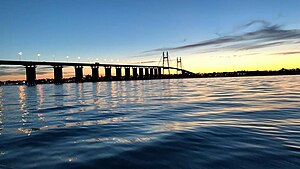Rosario-Victoria Bridge
Coordinates: 32 ° 52 ′ 11 " S , 60 ° 41 ′ 4" W
| Rosario Victoria Bridge | ||
|---|---|---|
| The bridge as seen from Rosario | ||
| Official name | Puente Rosario-Victoria | |
| use | Road traffic | |
| Convicted | 174 Rosario – Victoria | |
| Crossing of | Rio Paraná | |
| place |
Rosario , Victoria Argentina |
|
| construction | Cable-stayed bridge , viaducts and dams | |
| overall length | 59.3 km | |
| width | 21.3 m | |
| Longest span | 350 m | |
| Clear width | 300 m | |
| Clear height | 50.3 m | |
| start of building | 1998 | |
| opening | 2003 | |
| location | ||
|
|
||
The Rosario Victoria Bridge ( Spanish Puente Rosario Victoria ) is the slang term for the structure between the Argentine cities of Rosario in the province of Santa Fe and Victoria in the province of Entre Ríos .
In fact, the connection with which the national road 174 runs over the Rio Paraná and its extensive flood bed consists of several bridges , viaducts and dams. It is around 59 km long, 12 km of which are bridges and viaducts. The route, which begins as an extension of the Rosario ring road in its northern suburb of Granadero Baigorria , is initially four-lane on the main bridge, but only two-lanes with wide margins from the tollbooth to Victoria. The road officially called Conexión Vial Rosario-Victoria ( road connection Rosario-Victoria ) is toll road, pedestrians and cyclists are not allowed.
The construction work began in 1998, but was interrupted several times, in particular as a result of financial bottlenecks during the Argentina crisis , so that it could not be completed as planned in September 2002. The bridge was opened to public traffic on May 22, 2003.
Upstream, the Túnel Hernandarias, about 130 km away, is the next fixed crossing of the Rio Paraná. Downriver there is only the Complejo Zárate - Brazo Largo, about 230 km away .
Cable-stayed bridge
The main bridge, officially called Puente Nuestra Señora del Rosario , stands directly on the right bank and forms the beginning of the connection. It is a 608 m long and 21.3 m wide cable-stayed bridge built according to plans by Leonhardt, Andrä und Partner with a span of 350 m in the main opening and 120 m in the two side openings. It has a clear height of 50.3 m and therefore correspondingly long ramp bridges, which extend 1131 m long in the west into the town of Granadero Baigorria and in the east 2.4 km to the first embankment and the following toll station . The bridge and its ramps have four lanes with concrete guide walls on the sides and between the lanes. It has a sidewalk outside of the ropes, but there is no continuation beyond the ramp bridges.
The pylons and the girder of the cable-stayed bridge as well as the ramp bridges are made of reinforced concrete . The track girder is supported by 128 stay cables with a total weight of 740 t.
To protect the cable-stayed bridge from the impact of a ship, large ship deflector structures were erected at a clearance of 17.5 m in front of their pylons and the following seven piers of the ramp bridge on the river side. They consist of several steel pipes up to 60 m long and 2 m thick, which are filled with reinforced concrete and inserted into the ground at a distance of 5 m. The heads of the pillars are articulated to a very rigid reinforced concrete platform. The construction was the impact of a ship with a water displacement of 43,000 t (which corresponds to a ship 204 m long and 32 m wide) and a speed of 4.64 m / s (16.7 km / h or 9 kn ) downstream based on. These ship deflectors reduce the clearance between the pylons to 300 m.
Web links
- Rosario-Victoria Bridge. In: Structurae
- Rosario-Victoria, Argentina. In: roadtraffic-technology.com. Retrieved February 17, 2015 .
- Nelson Clivio: Puente Rosario-Victoria
Individual evidence
- ↑ a b Reiner Saul, Siegfried Hopf, Karl Humpf, Armin Patsch, Adelheid Backer: Innovative protection against ship impact for the Rosario – Victoria bridge over the Paranà (Argentina). Stahlbau 72 (2003), issue 7, p. 469.
- ↑ 2002, cable-stayed bridge over the Paraná River, Argentina. To Dywidag Systems
- ↑ Adelheid Bacher, Reiner Saul, Karl Humpf, Armin Patsch: Nonlinear calculations of composite steel piles on the ship deflector structures of the Rosario – Victoria bridge in Argentina (PDF, 293 kB)

